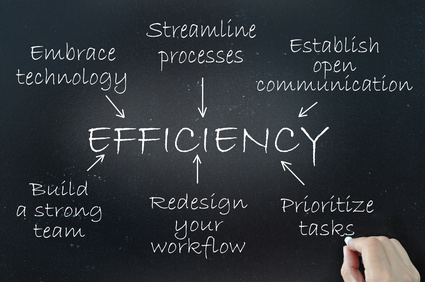10 Ways to Improve Business Efficiency
Easy ways to improve, create and evaluate the efficiency in and around your business
 As a business owner or manager, your goal is to try and sell more and spend less. If you are doing things correctly, both at the same time. This is the holy grail of profitability. It drives your business towards levels that it’s never seen before through improved customer service, user experience, and employee satisfaction.
As a business owner or manager, your goal is to try and sell more and spend less. If you are doing things correctly, both at the same time. This is the holy grail of profitability. It drives your business towards levels that it’s never seen before through improved customer service, user experience, and employee satisfaction.
Here’s the bottom line. Your employees need to be happy as well as your customers. If your customers are happy they’re going to buy more, they’re going to return to your store more, and they’re going to continue to say good things about you to others that might come in. If your employees are stuck doing redundant tasks that are boring, repetitive and don’t seem to produce any positive gain, then they’re not going to be happy. They’re not going to want to work in your business, and they’re probably not going to convey a pleasant attitude towards your customer.
To start creating, and improving business efficiency, there are a few simple things that you can do to try and make life better for you, your clients and your employees.
Try GigaBook’s Business Efficiency Tools
Think Like a Big Company, Operate Like a Small One
You can look at large companies, and I mean the big companies, the ones that have billions of dollars a year in sales, and you’ll see that they to analyze every part of their business. Companies that work with large shipping warehouses will measure the number of steps a worker has to take from point A to Point B and try to create the most efficient path. Why? Because doing so reduces the amount of labor that it’s needed to do something like shipping a package of the door.
Now you’re not going to have the ability as a small business owner to identify every step taken in your business. However, you should give some consideration to this kind of stuff. As a small business, you are nimble and able to make changes very quickly. You don’t have the same number of employees that the giant company has. That makes adjustment easy. You can make changes efficiently and promptly. Big companies don’t have this luxury. They have to go through all kinds of processes and evaluation and then deal with the fact that they have to implement these changes for thousands of employees across a large geographic area.
Automate Repetitive Processes
If there are things that occur in your business that are regular and repeatable, then they can quite possibly be automated through existing computer programs or software applications. When the world says there’s an app for that, they mean it.
You can create a lot of efficiency by having a repetitive process done by a computer program or other types of systems or methods that will reduce the number of overall time that it takes to do it.
GigaBook is an example of software that can perform repetitive tasks within your business. We specialize in appointment booking. With that, we do many other things that are related to the appointment process such as setting up reminders, notifying someone a new appointment exists, taking payments, creating invoices and sending them to online platforms like QuickBooks.
Automating repetitive processes also increase employee happiness. Why? Because no one wants to do the same thing 800 times in a row every day. It’s not stimulating or enjoyable.
Check for Redundant Processes
These are processes where the same thing is occurring multiple times. Most likely being done by multiple people within your business and still creating the same output. Doing the same thing twice. Well, it costs twice as much. It’s pretty simple and easy to figure out when out where this might be occurring too.
If you want to try to reduce redundant processes you first have to start looking to where overlap might exist. Are you collecting the same information or data from two different places? Do you have two different people inputting the same information? By centralizing some of this information you can quickly and easily begin to reduce the amount of time spent performing these tasks while at the same time removing redundancy from your overall processes.
Reduce the Total Number of Steps for Doing ANYTHING
The number of steps that it takes to do any do or perform any process in your business are going to directly relate to the amount of time that it takes to do so. Often as enterprises grow things change and with these changes sometimes that things that SHOULD change, DON’T.
The easiest way to increase efficiency in your business is to eliminating processes that don’t produce a positive gain. A simple example is a process that is in place with the intention of preventing some kind of loss. If that loss were to occur it might cost your business $500. But does the labor, effort and other resources needed to perform these loss prevention exercises outweigh the loss you are trying to prevent? If so, it’s not creating any efficiency or savings. It’s actually costing you more money.
Make Sure the Right People are Doing the Right Jobs
Do you have someone that is earning $40 an hour doing a job that can be performed by someone that makes $10 an hour? It’s a simple formula to figure this out. If someone makes four times more than another person they should be doing the job four times faster or four times better. Think about it if you can reduce your cost of doing anything by 2, 3, or 4 times. That’s a pretty big gain in efficiency.
Reduce the Number of Meetings You Have
A one-hour meeting with ten employees that make $15 an hour costs you $150. That meeting also removed 10 hours of productive activity that could have occurred in your business. I’m not suggesting that you don’t have meetings just don’t have meetings for the sake of having meetings. That’s inefficient. However, when you do have meetings they should have a purpose, as well as discussion about efficiency and productivity.
But it Only Takes a Minute
It’s really easy to say this. But are you in tune with what the cost of each of those minutes are and how much they add up to over the course of a year? You can make a dramatic impact on the bottom line of your business by simply recapturing some of these minutes.
Here is the cost per minute of different employees, with different wages:
- $10 per hour = 16 cents
- $15 per hour = 25 cents
- $20 per hour = 33 cents
- $25 per hour = 42 cents
- $30 per hour = 50 cents
- $40 per hour = 67 cents
- $50 per hour = 83 cents
- $60 per hour = 1 dollar
Here is what 8 minutes a day is worth over a 50 week year:
- $10 per hour = $320
- $15 per hour = $500
- $20 per hour = $660
- $25 per hour = $840
- $30 per hour = $1000
- $40 per hour = $1340
- $50 per hour = $1660
- $60 per hour = $2000
Used To-do lists to Delegate, Alert and Remind
To-do lists are a great way to delegate or organize tasks within your business. GigaBook has an online to-do list that you can use to assign, notify, remind or alert those you work with about various tasks within your business. The greatest part about this, you don’t need to post, share or have any paper to distribute these lists. It’s all there, inside of GigaBook.
Prioritize
Look it’s pretty simple. You should be doing the things that either save money or making money first. Any other tasks aren’t as aren’t as high of a priority. If you aren’t doing the things that are most important to you and your business first, then you’re doing something wrong. You need to prioritize in order to be effective. It’s really that easy.




